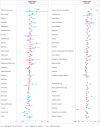GP consultation rates for sequelae after acute covid-19 in patients managed in the community or hospital in the UK: population based study
- PMID: 34965929
- PMCID: PMC8715128
- DOI: 10.1136/bmj-2021-065834
GP consultation rates for sequelae after acute covid-19 in patients managed in the community or hospital in the UK: population based study
Abstract
Objectives: To describe the rates for consulting a general practitioner (GP) for sequelae after acute covid-19 in patients admitted to hospital with covid-19 and those managed in the community, and to determine how the rates change over time for patients in the community and after vaccination for covid-19.
Design: Population based study.
Setting: 1392 general practices in England contributing to the Clinical Practice Research Datalink Aurum database.
Participants: 456 002 patients with a diagnosis of covid-19 between 1 August 2020 and 14 February 2021 (44.7% men; median age 61 years), admitted to hospital within two weeks of diagnosis or managed in the community, and followed-up for a maximum of 9.2 months. A negative control group included individuals without covid-19 (n=38 511) and patients with influenza before the pandemic (n=21 803).
Main outcome measures: Comparison of rates for consulting a GP for new symptoms, diseases, prescriptions, and healthcare use in individuals admitted to hospital and those managed in the community, separately, before and after covid-19 infection, using Cox regression and negative binomial regression for healthcare use. The analysis was repeated for the negative control and influenza cohorts. In individuals in the community, outcomes were also described over time after a diagnosis of covid-19, and compared before and after vaccination for individuals who were symptomatic after covid-19 infection, using negative binomial regression.
Results: Relative to the negative control and influenza cohorts, patients in the community (n=437 943) had significantly higher GP consultation rates for multiple sequelae, and the most common were loss of smell or taste, or both (adjusted hazard ratio 5.28, 95% confidence interval 3.89 to 7.17, P<0.001); venous thromboembolism (3.35, 2.87 to 3.91, P<0.001); lung fibrosis (2.41, 1.37 to 4.25, P=0.002), and muscle pain (1.89, 1.63 to 2.20, P<0.001); and also for healthcare use after a diagnosis of covid-19 compared with 12 months before infection. For absolute proportions, the most common outcomes ≥4 weeks after a covid-19 diagnosis in patients in the community were joint pain (2.5%), anxiety (1.2%), and prescriptions for non-steroidal anti-inflammatory drugs (1.2%). Patients admitted to hospital (n=18 059) also had significantly higher GP consultation rates for multiple sequelae, most commonly for venous thromboembolism (16.21, 11.28 to 23.31, P<0.001), nausea (4.64, 2.24 to 9.21, P<0.001), prescriptions for paracetamol (3.68, 2.86 to 4.74, P<0.001), renal failure (3.42, 2.67 to 4.38, P<0.001), and healthcare use after a covid-19 diagnosis compared with 12 months before infection. For absolute proportions, the most common outcomes ≥4 weeks after a covid-19 diagnosis in patients admitted to hospital were venous thromboembolism (3.5%), joint pain (2.7%), and breathlessness (2.8%). In patients in the community, anxiety and depression, abdominal pain, diarrhoea, general pain, nausea, chest tightness, and tinnitus persisted throughout follow-up. GP consultation rates were reduced for all symptoms, prescriptions, and healthcare use, except for neuropathic pain, cognitive impairment, strong opiates, and paracetamol use in patients in the community after the first vaccination dose for covid-19 relative to before vaccination. GP consultation rates were also reduced for ischaemic heart disease, asthma, and gastro-oesophageal disease.
Conclusions: GP consultation rates for sequelae after acute covid-19 infection differed between patients with covid-19 who were admitted to hospital and those managed in the community. For individuals in the community, rates of some sequelae decreased over time but those for others, such as anxiety and depression, persisted. Rates of some outcomes decreased after vaccination in this group.
© Author(s) (or their employer(s)) 2019. Re-use permitted under CC BY. No commercial re-use. See rights and permissions. Published by BMJ.
Conflict of interest statement
Competing interests: All authors have completed the ICMJE uniform disclosure form at www.icmje.org/disclosure-of-interest/ and declare: support from BREATHE for the submitted work; no financial relationships with any organisations that might have an interest in the submitted work in the previous three years; no other relationships or activities that could appear to have influenced the submitted work.
Figures





Comment in
-
Post-acute covid-19 in primary care.BMJ. 2021 Dec 29;375:n3080. doi: 10.1136/bmj.n3080. BMJ. 2021. PMID: 34965928 No abstract available.
References
Publication types
MeSH terms
LinkOut - more resources
Full Text Sources
Medical
